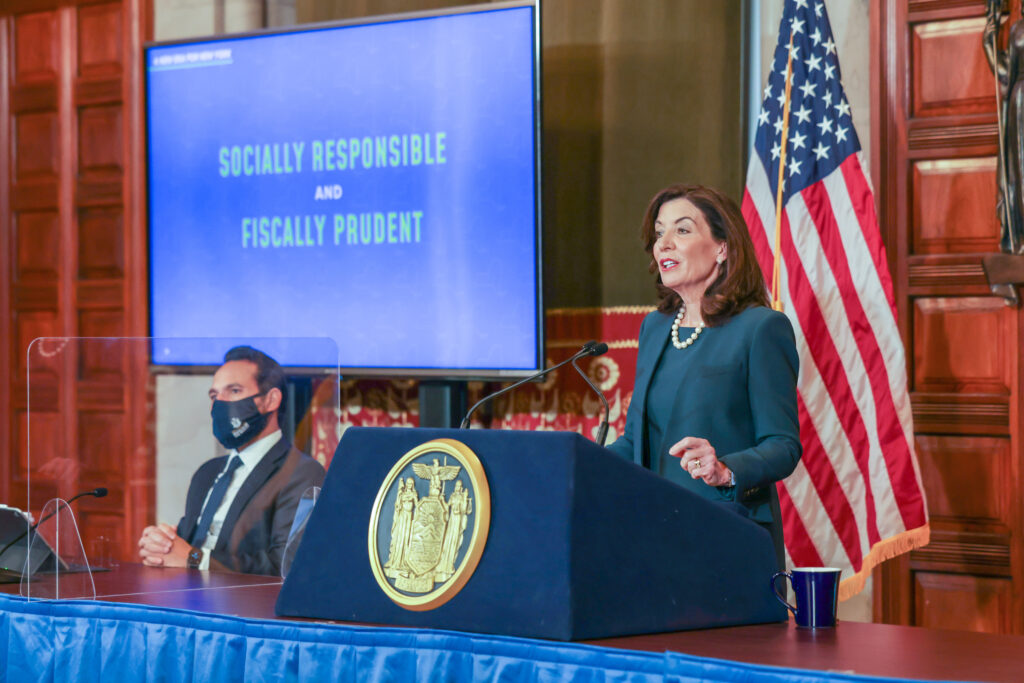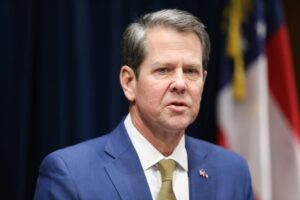Hochul Balanced Budget Proposal Banks on Wealthy Staying Put

When Robert Mujica was former Gov. Andrew Cuomo’s budget director, he routinely brushed off complaints that New York had set aside paltry sums in reserve to deal with future crises.
Now that he’s Gov. Kathy Hochul’s budget director, he is trumpeting her decision to set aside some $16 billion over the next five years so that the state can be well prepared for the next recession or pandemic.
How times have changed in Albany.
The first budget from Hochul proposes to spend more than $216 billion in the fiscal year that begins April 1, cut income taxes for families in the middle class and property taxes for most homeowners, and shore up the state’s finances. All of this is possible thanks to much higher than expected tax revenue and a gusher of federal pandemic aid.
The bottom line: Hochul is promising balanced budgets for the next five years without program cuts or tax increases.
“This is the first time the Division of the Budget has ever published a budget without an out-year budget gap,” Mujica said in a briefing Tuesday — referring to deficits that usually get projected for future years.
It remains to be seen whether the legislature, dominated by progressive Democrats, will agree to put aside so much money for the next crisis. And the budget perpetuates the debate over whether the state’s high taxes on the wealthy — increased last year — are fueling an exodus from the state by people who pay the lion’s share of taxes.
“This is an unprecedented opportunity to take care of New Yorkers’ needs and take care of the future,” said Andrew Rein, president of the budget watchdog group the Citizens Budget Commission. But he also expressed concern about a potential upward spiral in spending once negotiations with lawmakers begin.
Said Rein: “The risk there is a feeding frenzy in budget negotiations with the legislature. Usually the governor’s budget is a floor.”
Taxing the Wealthy
The $216 billion, which includes money from the federal government for programs like Medicaid, is about 3.5% higher than will be spent in the current year ending March 31.
Hochul applied the surplus she expects for the current year and federal aid to $7 billion-plus in pandemic-related programs designed to provide short-term assistance. These include $2 billion for pandemic aid efforts, $2.2 billion for property tax relief, $1.2 billion to speed up the income tax cut, $2.8 billion in bonuses to health care workers and capital needs of hospitals, and $350 million in additional help for businesses, including entertainment enterprises.
Hochul’s plan also includes permanent increases in spending for education and health care, as well as an expansion of child care aid to families.
The state now expects $4 billion more in revenue for this fiscal year than it estimated in October. It also raised its estimates of tax revenue by $5 billion for each of the coming years.
It is the use of state revenues to pay for permanent spending increases paid for with state revenues that worries fiscal experts.
Hochul’s budget hiked up its projections for future tax revenue at a time when the state is losing population — and possibly a disproportionate number of high-income taxpayers. The state’s top 1% of taxpayers account for more than 40% of all income taxes collected.
Last year, the state increased taxes on individuals making more than $1 million annually and couples that make more than $2 million per year, to 9.65% from 8.82%. Those who make more than $5 million per year saw their personal income tax rate grow to 10.3%, and New Yorkers bringing in more than $25 million annually will see a rate of 10.9%.
For wealthy city residents, it all adds up to more than the 13% tax rate imposed by California, previously the highest in the country.
While the U.S. Census reported recently that the state’s population declined by 300,000 last year, with the biggest losses likely from the city, Mujica said there was no evidence that the state tax increase was causing people to leave.
He attributed any losses to the 2018 end of unlimited deductions for state and local taxes — known as the SALT deduction — which had a far higher impact on taxpayers than the state tax increase.
Others disagree, saying that the flight is obscured because as long as a person’s job is based in the city they have to pay taxes here, even if they work remotely — bringing in revenue for now but ultimately propelling businesses to relocate.
“Ask anyone who manages wealth or prepares tax returns and they will tell you that many clients are in the process of moving their residence to lower-tax environments,” said Kathryn Wylde, chief executive of the business group Partnership for New York City. “It is not until the job location moves out that the state will feel the impact. That takes much longer, but eventually the companies will follow their people.”
Rainy-Day Fund
Hochul is planning for the future with a rainy-day fund — money set aside to weather adversity.
Under Cuomo, New York’s reserves ranked 41st among the 50 states, according to an analysis by the Pew Charitable Trust. Hochul envisions a five-year program to build up those reserves to 15% of state operating expenses, or $19 billion, which would put it well above the national average.
Such an increase may not be enough. Since New York relies so heavily on taxes from wealthy residents whose income jumps when stocks, bonds and real estate soar and declines dramatically when markets fall, New York State needs as much as 27% of spending in a rainy-day fund, the Citizens Budget Commission argues.
“There is no way the 15% should be lowered in negotiations,” Rein added.
Initial reaction of the budget was positive. State Comptroller Thomas DiNapoli, who had been critical of recent Cuomo budgets, released a short statement that said the state needs to make sure that its increased spending is effective and praised the plan to increase reserves.
Some progressive groups issued statements that commended the increase in spending but said it was inadequate to meet the needs of New Yorkers.
It will be up to Hochul to maneuver the legislature to adopt a budget that follows her outline — a task that may not be easy.
“Cuomo played the role of a check on the free-spending legislature,” noted Peter Warren, of the conserative leaning Empire Center. “Hochul has talked about working with the legislature, but she is going to have to be assertive of her position.’’
This article was originally posted on Hochul Balanced Budget Proposal Banks on Wealthy Staying Put







